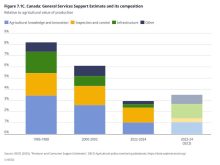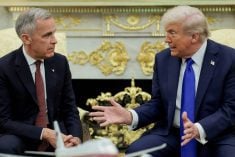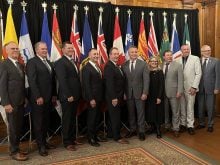If Canada wants to continue to grow its agriculture trade in one of the fastest growing regions of the globe, it needs a new strategy.
It needs to reconsider its ‘trade mission’ diplomacy strategy in the Indo-Pacific region and become relevant to the countries there.
“Economic interests can no longer be separated from broader foreign policy and defence objectives, and I think this is something that makes Canada really uncomfortable,” said Meredith Lilly, who holds the Simon Reisman Chair in International Affairs focused on trade policy and was a former foreign affairs and international trade advisor to Prime Minister Stephen Harper.
Read Also

PepsiCo nearly doubles regenerative scope
Another 240,000 farm acres managed through regenerative agriculture will be supported by PepsiCo across Manitoba and Saskatchewan by the end of 2025.
Lilly was part of an online discussion hosted by the MacDonald Laurier Institute that examined Canada’s Indo-Pacific strategy.
“We have long sought to benefit from Indo-Pacific economic growth without getting our hands dirty in some of the deeper defence and foreign policy challenges,” she said.
It’s an understandable position to take. Getting mired in regional geo-politics is expensive and comes with the danger of appearing to pick a side.
“It is also what I regard as the desire to look at the Indo-Pacific region through a very self-interested, domestic lens — both economically as well as geopolitically,” Lilly said.
But times have changed, and that’s not likely to be a winning strategy in coming years, she said.
“It’s no longer possible to separate those things as neatly as we would have liked to,” she said. “We can’t just be in the CPTPP (Comprehensive and Progressive Agreement for Trans-Pacific Partnership) and not be thinking about what’s happening in maritime security, for instance.”
It’s also becoming increasingly difficult not to ‘pick a side.’ Russia’s invasion of the Ukraine reinforces this point.
“We also see a U.S.-China rivalry increasing in the coming years,” Lilly said. “I think all countries in the region want to avoid choosing sides.”
But there are times where choices need to be made. Lilly points to Canada’s Huawei 5G decision as an example.
“We took three years to make it because we were so incredibly uncomfortable with picking sides on this issue,” she said.
‘Strategic error’
Canada has worked for decades to develop trade with China and the fruits of that labour have paid dividends.
“Canada has looked to China as sort of a counterweight to our trade dependence with the United States,” Lilly said. But she suggests those efforts amounted to diversification by replacing one big market with another.
“I think that that was a strategic error on Canada’s part and something that we need to move away from,” she said.
Lilly suggests that because the United States is Canada’s biggest and most important trading partner and also its next door neighbour, that relationship should be reflected in this country’s Indo-Pacific strategy.
Aligning with the United States could also help open doors and ameliorate perceptions of Canada’s irrelevance to the region.
“The criticisms of Canada that I’ve encountered in the past at forums like ASEAN (Association of Southeast Asian Nations) and APAC (Asia Pacific) is that we’re inconsistent — we’re sort of this fair-weather friend,” Lilly said.
She stressed the importance of demonstrating Canada’s long-term commitment to the region and shaking off the transactional, economic self-interest reputation that it has, fairly or unfairly, earned.
Canada’s invisibility in the Indo-Pacific region is a big obstacle. Many experts say the country’s late arrival to the party in the region means it will be playing catch up.
Thomas Wilkins, senior fellow, Australian Strategic Policy Institute, was another participant in the Macdonald-Laurier webinar, and he said strategists should be aware of concerns about Canada’s relevance on the Indo-Pacific stage. Wilkins participates in one of Australia’s premier foreign policy think tanks, the Lowy Institute for International Policy.
“The think tank produces a data-driven report called The Asia Power Index, which seeks to capture a spectrum of metrics in order to rank relative power differentials in the Indo-Pacific,” Wilkins said. “Canada is not included in this index, or anywhere in the accompanying report.
“It speaks volumes that a significant middle power state like Canada can be overlooked like this, while countries like Nepal, Laos and Brunei are featured in the index.”
The fact that the report is produced by Australia, a like-minded ally with shared histories, values and interests, is noteworthy.
“Often Canada and Australia are mentioned in the same breath as archetypical middle powers that take proactive roles in regionalism, multilateralism, coalition building and all around good international citizenship,” Wilkins said. So, for him, Canada’s exclusion from the report defies expectations.
Of course, Australia is at the geo-political centre of the Indo-Pacific region, while Canada is an ocean away, but Wilkins’ example still illustrates the hurdles Canada faces if it wants to gain influence in the region.
Slowpoke nation
Another hurdle is that Canada has arrived late to the party. While the country is physically removed from the region, the UK, France, Germany and even the Netherlands are ahead of Canada in forging Indo Pacific strategies.
“We have been exceedingly slow to realize the full potential and challenges of what is now known as the Indo-Pacific region,” said James Boutilier, distinguished fellow, Macdonald-Laurier Institute, and another participant in the webinar.
Boutilier suggested that Canada may have regressed in the past few decades, pointing out that in the 1980s, Canada’s trans-Pacific trade exceeded trans-Atlantic trade.
Lilly echoed that sentiment.
“Canada’s timing is something worth underscoring. We are very late to the party. We are sort of the last ones on the dance floor, and there’s maybe no one left to dance with,” she said. Lilly worries that Canada is placing itself in a position of isolation from like-minded allies.
“The U.S., Australia, Japan all have this coordinated, concerted path for the region, and we’re not part of it, and we should be really worried about that and the reasons for it,” Lilly said.
Nevertheless, there is reason for optimism. While Canada is a latecomer, there appears to be momentum. The active engagement of the Canola Council of Canada, Cereals Canada and Pulse Canada in pushing for a new trade diversification office to be located in the region bodes well for the agricultural sector, panellists said. And its like-minded allies in the region are still allies. Wilkins thinks Canada’s absence at the table is missed by allies in the region.
“I think it’s a near certainty that a more proactive Canadian role would be welcomed within the region,” he said.
Important market
The Indo-Pacific region is already important to Canada’s agricultural sector.
Roughly half of Canada’s non-durum wheat exports, 75 per cent of Canada’s lentil and pea exports and more than 40 per cent of Canada’s canola seed, oil and meal exports are bound for countries there.
But the region still offers a tremendous opportunity to grow those exports. It is the fastest growing and most dynamic economic region in the world. It contains 60 per cent of the world’s population and 40 per cent of the world’s economic output.
The federal government recently announced it was establishing an Indo-Pacific Advisory Committee tasked with providing independent perspectives and recommendations on Canada’s Indo-Pacific strategy. In early June, the Canola Council of Canada, Cereals Canada and Pulse Canada released a joint report making the case for Canada’s agricultural sector to play an important role in that strategy, while also pushing for a new trade diversification office to be located in the region.
















